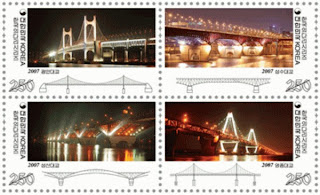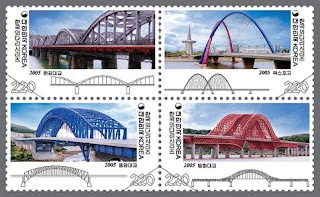
Gasan Bridge, Gasan, Marinduque
Though no date was gathered pertaining to the building of the Gasan Bridge, it is known to be from the mid-to late American period. Built of concrete, the bridge spans the Matandang Gasan River. The bridge stands on plain concrete piers and is decked by concrete lattice work parapet walls. Recently, the bridge has been converted into a promenade with decorative lampposts installed and recent repainting.
Hinigaran Bridge, Hinigaran, Negros Occidental
Situated along kilometer 53 south of Bacolod in the town of Hinigaran is a 100.00 meters long Hinigaran Bridge. Spanning the river with the same name, Hinigaran Bridge was built in 1935 following a standard bridge design popularized during the time. Composed of 14 graceful piers supporting beams, the bridge, which is 6.00 meters wide, is designed with a protective parapet wall with balusters lining its side. This design which became standard for most bridges in the country still abounds throughout the archipelago. Like most American period bridges whose roadway is deemed narrow today, Hinigaran Bridge was decommissioned when the new alternative concrete bridge was constructed alongside it. Today, Hinigaran Bridge serves as a convenient platform and recreational space for "Talaba" breeders and local promenaders.
Wahig Bridge, Dagohoy, Bohol
Built in 1929, the Wahig Bridge in Dagohoy, Bohol links the inner towns of Dagohoy with Carmen, Bilar and Loboc to the south. Crossing the Wahig River, the bridge is of a single trussed span with a concrete abutment on both sides of the bridge's approach. Unlike other American era bridges which have been replaced in the past due to increasing traffic load, the Wahig bridge, being located in the interior road bisecting the island province experiences relatively light to moderate traffic load resulting in its still constant use and eventual survival.
Pan-ay Bridge, Pan-ay, Capiz
Spanning the Pan-ay River, Pan-ay Bridge is a single spanned segmented arched concrete bridge. Like most bridges built sometime in the 1930's, the Bureau of Public Works followed standard designs for most spans built around the country. Characteristic about these bridges is the use of closely spaced balusters to adorn and protect the edges of the bridge. Segmented arches were also popular in the design of the Bureau for it allowed a wider gap to be spanned compared to the rounded arch popularized by the Spanish builders which would require the building of added support piers. The Pan-ay Bridge is still much in use and connects the town proper of Pan-ay with Western towns of Capiz and Iloilo.

Quezon Bridge, Quiapo, Manila
Inaugurated in 1938, the Quezon Bridge, also referred to as the Quiapo Bridge, replaced a much earlier narrow suspension bridge, the Puente Colgante built in 1852. The bridge designed to mimic the famous Sydney Harbor Bridge is in the Art Deco style with elegant approach towers supporting the single metal trussed arched span. Unlike other bridges that span the Pasig River, Quezon Bridge has a relatively high clearance and a long northern approach which allows below its numerous supporting arches shops and stalls to be located. This has become famous for the cacophony of locally made products and handicrafts sold underneath the bridge as well as a convenient turn-around for vehicles plying the bridges access road, Quezon Boulevard. Quezon Bridge was damaged during the Second World War, and unlike other bridges that spanned the Pasig was reconstructed in 1946 following its original design.
Governor Reynold's Bridge, Guinobatan, Albay
Bridge was inaugurated in 1911 and is composed of two reinforced arched spans. Traversing the Banao River, it links the town of Guinobatan with that of Lig-ao and Camarines Sur further north. When built it cost the American colonial government P40,000 pesos. Governor Reynold's Bridge replaced an earlier span built during the Spanish colonial period in 1860 which itself was subsequently destroyed by a powerful earthquake in 1864. The bridge was designed with two reinforced concrete arch spans supporting concrete piers holding the road deck. This design was utilized by the American engineers for many similar spans found throughout the country. Governor Reynold's Bridge, which amongs the locals is more familiar as the Banao Bridge still facilitates all forms of road traffic almost a hundred years since it was inaugurated.
Mauca Railway Bridge, Ragay, Camarines Sur
Built in 1937 in time for the inauguration of the South line to Bicol in 1938, the Mauca Railway Bridge is unique not for its length but more for its uniqueness due to its construction, with box girders along its approaches and an inverted truss designed like an arch situated in the bottom of the deck crossing the river. The bridge which spans the Mauca River still carries rolling stock, from trains to the more frequent makeshift trolleys that serve most of the railway communities along the track.
Balucuan Bridge, Dao, Capiz
In the town of Dao spanning the Balucuan River in the Province of Capiz stands a single spanned bridge known as Balucuan Bridge. Though no year was gathered as to its building, its design and construction is inimical to other American period concrete arched spans such as the Governor Reynold's Bridge in Albay. The bridge is composed of only one concrete arch span that supports above its arch with small arches holding the road deck. The deck itself is only 4.40 meters wide while the bridge is roughly 20.00 meters long. Today built almost beside it, a new wider span carries the growing traffic along the main national road that links Capiz with Iloilo, Balucuan Bridge today has been sidelined and has become for the town of Dao a sort of linear garden and greeting station for those entering town.
Stamp Issue: 2008-05-16






























